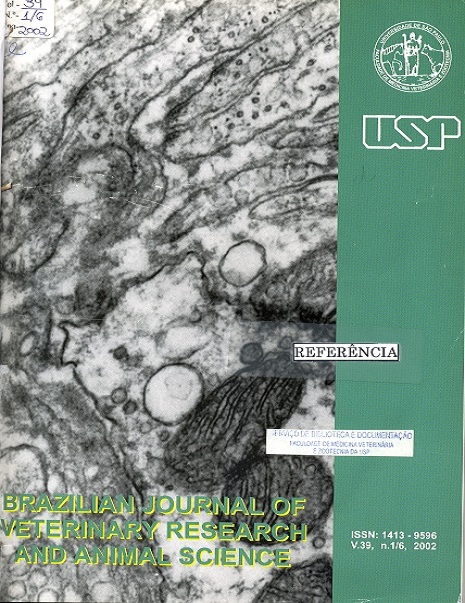Inquiry of cases of myiasis by Dermatobia hominis in dogs of the southern zone of Rio de Janeiro municipality in 2000
DOI:
https://doi.org/10.1590/S1413-95962002000400003Keywords:
Dog, Myiasis, Dermatobia hominis, Warble fly, InquiryAbstract
In the Southern Zone of Rio de Janeiro municipality, it was performed an inquiry about myiasis by Dermatobia hominis larvae in dogs presented to 34 veterinary establishments during 2000, to identify predisposing factors, and to contribute to the comprehension of epidemiological features and prevention of this disease. At least one case was presented to 24 establishments, and adult, male, light and short-haired, and pure breed dogs were most infected. Most affected body regions were those that flies can easily access: limbs, dorsal region, lumbar region, head, and neck. In most cases, no complications were observed during and after the treatment, and healing time was less than five days. As no month of the year presented higher occurrence of cases, prevention programs should be developed during all the year, based on epidemiological data as phenotypical features (breed, hair color, hair size, age, and sex) of infested animals. Pet owners should be encouraged to look for veterinary assistance when larvae are found on the animals, and to maintain environmental hygiene. Prevention programs should be developed specially in areas where D. hominis and flies that play the role of D. hominis egg vectors are found, because most dogs have became infected when traveling to small farms outside the studied area, and, then, cases of myiasis were found in a predominantly urban area as the Southern Zone.Downloads
Download data is not yet available.
Downloads
Published
2002-01-01
Issue
Section
UNDEFINIED
License
The journal content is authorized under the Creative Commons BY-NC-SA license (summary of the license: https://
How to Cite
1.
Cramer-Ribeiro BC, Sanavria A, Oliveira MQ de, Souza FS de, Rocco F da S, Cardoso PG. Inquiry of cases of myiasis by Dermatobia hominis in dogs of the southern zone of Rio de Janeiro municipality in 2000. Braz. J. Vet. Res. Anim. Sci. [Internet]. 2002 Jan. 1 [cited 2024 Jul. 26];39(4):176-80. Available from: https://www.revistas.usp.br/bjvras/article/view/5963





